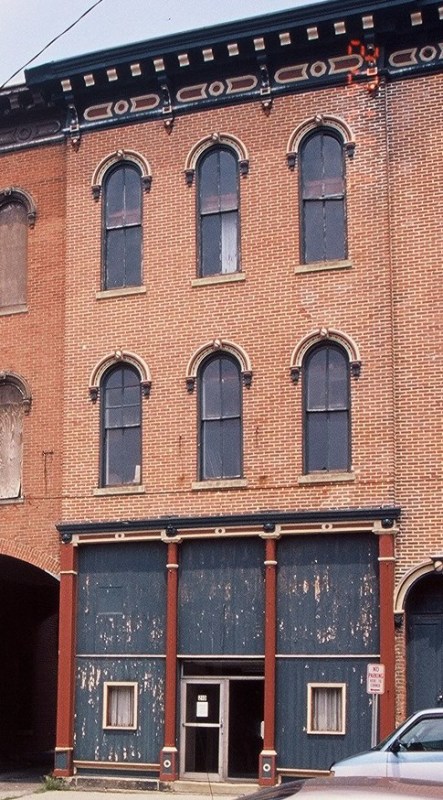Notes on the 20% tax credit: when your project starts matters
As you know (especially if you took an active role in our recent advocacy push) the preservation community managed to save the 20% rehab tax credit when sweeping tax reform was passed last month. But what does that mean for rehab projects going forward? As we transition to a credit that pays out 4% of the credit per year for 5 years (once the building is placed in service), however, the bigger question may be, when do rules for the new credit go into effect?
If you’re planning to start a project, and were hoping to take advantage of the prior credit provisions, here are two important points to keep in mind: 1) you needed to be the building owner by December 31, 2017, and 2) you need to begin work (incurring expenses on the project) no later than 180 days after the legislation went into effect (prior to the end of June).
Of course, buying or leasing a property now automatically puts you into the new 20% tax credit rules, but if you were looking to start turning dirt on a project from 2017 or before, be aware that the clock is ticking.
![]()
The future of the 20% rehab tax credit: brighter than I thought
If you’re like me, you’ve probably got a favorite Oscar Wilde quote. One of his memorable thoughts that has stuck with me through the years is this one, defining a cynic as someone “who knows the price of everything and the value of nothing.” So today, I want to do just a little gentle revision to Wilde’s quote to read:
Beware the politician who knows the price of everything and the value of nothing.
And why am I picking on politicians as a group (and specifically our Congressional body)? Because the 20% rehab tax credit is on the chopping block, courtesy of those men and women in Congress.
Why? Not because it’s an overly onerous regulation (it’s a voluntary tax incentive), not because it’s a drain on the federal treasury (in fact, the latest NPS report on the credit states the credit has generated 29.8 billion dollars in federal tax revenue, against 25.2 billion dollars paid out, over the course of the credit’s existence), not because it’s a job killer (when $1,000,000 spent on rehab creates more jobs than $1,000,000 spent on new construction), and not because Republicans today are trying to do right by the legacy of Reagan (indeed, Reagan talks up the tax credit in a clip, jazzed up with some National Trust commentary, here). And not because new construction is such a boon to payroll tax receipts. The opposite is true, but you’d think keeping an incentive that boosts payroll tax, creates jobs, and does our collective heritage right would be a no-brainer.

The rehab tax credit? It’s a great program! I’m afraid we’ll have to kill it.
No, I think it’s on the chopping block because we, as regular citizens, need another reason to plant our collective face in our palms while we mutter about the utter lack of common sense in DC. When it comes to tax credits at the federal level, the fewer the better, whether or not they help inject serious capital into worthwhile redevelopment projects, whether or not they bring more net dollars into the treasury than they cost, whether or not they help save a bit of our collective history here and there. It’s enough to make me want to beat my head against a wall at the sheer lack of thoughtfulness, or careful evaluation to determine where tax credits actually make sense for the greater good, and to keep those tax credits in place, much like the administration and Congress have done with the affordable housing tax credit.
So, while I’d like to think that politicians can be brought back to reality, and that if enough people explain the benefits of an incentive program that they’ve obviously missed or glossed over, the 20% rehab tax credit will be inserted with haste back into the tax bill, my personal outlook on this happening is very gloomy. I’m guessing that the people in power made up their minds long ago on who wins and who loses in the incentives game, and no amount of good information is going to change the outcome.
I think we’re right, as preservationists. I think we’re on the right side, and we’re going to lose anyway. And that reality of the political process just ups my level of pessimism when it comes to politics, making me into that cynic that Wilde was warning you about.
Update 1/4/2018: So, we all know what happened: the 20% tax credit was not killed, but saved, in the tax reform legislation. Politicians went to work, the DC sausage machine cranked up, and in the end we got a new tax law. Sure, maybe we got tax credit links when we were expecting patties. And, maybe we were expecting five, and only got four, but we have our sausage, er, tax credit incentive, still intact, and still a very strong tool in our redevelopment toolbox. Now, it’s just up to the smartest preservationists in the room to figure out how to maximize the effectiveness of the tax credit going forward.
With that in mind, the National Trust has scheduled a “Now What?” webinar to give us an understanding of how the revamped tax credit will likely operate going forward, and whether we can all take a breather regarding tax advocacy (Hint: No). We hope to “see” you there!
Tuesday, January, 2pm EST
Free Webinar: Understanding the Historic Tax Credit Post Tax Reform
To register, visit: https://attendee.gotowebinar.com/register/7285418309228831490
On December 19th, 2017, Congress once again acknowledged historic preservation as a valuable economic development tool when it retained the 20% Historic Tax Credit in its tax bill. The credit’s retention is a significant accomplishment for preservationists, architects, contractors, mayors, Main Street organizations, developers, and property owners of historic buildings in towns across America.
Join this webinar to hear a recap of the bill’s provisions, the possible impacts of phasing on historic rehabilitation projects and the potential legislative vehicles that might be available in the remaining months of the 115th Congress to make changes.
![]()
The Tax Credit Roundup
We’re celebrating the most recent announcement of Ohio Historic Preservation Tax Credit awards (Round 15, for those of you keeping score). Here’s a selection of newspaper articles from across the state, highlighting some of the award recipients and their projects.
This cincinnati.com article provides an overview of the Cincinnati projects receiving credits.
Check out an overview on Cleveland projects from Crain’s here.
In Cleveland, the downtown Huntington Building will use its $25 million catalytic award to help defray a $270 million project. Read more here.
An iconic Bexley movie theatre is among the Columbus-area projects to benefit from the latest OHPTC round. Read more here.
Dayton’s long-neglected Steam Plant will receive tax credits to spur its redevelopment.
In Eaton, a former high school will be converted into senior housing.
Downtown Newark’s Brunswick Building is slated for redevelopment.
Wittenberg joins a growing list of Ohio universities utilizing tax credits to redevelop their historic buildings. Read more here.
For the basics of the program, you can learn more at ODSA’s website here.
ODSA releases list of Round 15 OHPTC recipients
This morning at the Drexel Theatre in Bexley, the Ohio Development Services Agency released its list of state tax credit recipients. With total project costs ranging from $300,000 to $270 million (yes, really…270 million dollars), the OHPTC program shows its worth to the big projects in the 3 Cs of Ohio, as well as in the smaller, courthouse communities. Congratulations to all of this round’s recipients! Read the ODSA release here.
Advocacy Alert: Proposed tax credit act needs your support!
To the excitement of preservationists across the country, the Historic Tax Credit Improvement Act (HR 3846) was introduced Wednesday, October 28. So why the excitement? For starters, HR 3846 offers the following tax credit improvements:
1) Small deals (less than $2.5 million in qualified rehabilitation expenditures) would see the eligible credit jump from 20% to 30%.
2) Transfer of credits as a tax certificate could give owners of smaller projects greater flexibility to bring in investors, and make capital easier to access.
3) Substantial rehabilitation (the threshold for becoming eligible to take advantage of the credits) would drop to 50% of the adjusted basis from the current 100%.
Add in better treatment of state tax credits when it comes to federal taxation, and other improvements, and you can begin to see how these changes, if passed, could inject a wave of new investment for countless small project rehabs.
Here in Ohio, we have Representative Pat Tiberi, and Representative Mike Turner to thank for helping lead the way as original co-sponsors of the bill, but we’re reaching out to you today, to encourage you to contact your representative, to ask him or her to sign on as co-sponsors for HR 3846 (or to thank Reps Tiberi and Turner for their support). You can find your representative here.
Check out this one-pager from the Trust, which summarizes the bill and how it improves the current federal historic tax credit.
The 10% (residential) tax credit…no, really! Pt II
We left off with my promise to share what I found out about the 10% tax credit, and just what you could or couldn’t do with it when it comes residential rehabilitation.
I started by checking out Form 3468 from the IRS, the form you attach to your return (you can view a PDF of the form here). One definite advantage to the 10% credit is the fact that there’s no 3-part process involving the SHPO, the National Park Service, the IRS, and your raft of consultants (depending on the complexity of your project). You report your 10% credit on a three-page form that you include in your annual return. And really, it’s one line multiplying your Qualified Rehabilitation Expenditures by 10%, and entering that total on the last line of the form.
In consulting the 2013 Instructions for Form 3468 (which you can find here) because nothing with the IRS is as easy as writing the total in one line, we learn that the Qualified Rehabilitation Expenditures have to be for “nonresidential rental property.” So what exactly does that mean? Sorry, the IRS can’t be bothered with including definitions for common terms used on the form. That would be…helpful.
However; undaunted, and hot on the trail of this mystery, I google “nonresidential rental property definition” and then I google “residential rental property definition” which brings me to the next IRS publication. IRS Publication 527 covers residential rental property (yep, I’ve got your link for it here) and the IRS gets into property classes. While the classes don’t include “nonresidential rental property,” we do get a definition for “residential rental property” as follows:
This class includes any real property that is a rental building or structure (including a mobile home) for which 80% or more of the gross rental income for the tax year is from
dwelling units….
So, does that mean the inverse applies for the definition of nonresidential rental property? As long as less than 80% of your income comes from dwelling units, is your property defined as nonresidential rental property in the eyes of the IRS? I kept searching.
A fair amount of googling later, I came upon IRS Publication 946, which delves into property depreciation (you glutton…here you go) and the good folks at the IRS included a glossary in the publication. Their definition for residential rental property (sorry, nothing under the Ns for nonresidential rental property) is:
Real property, generally buildings or structures, if 80% or more of its annual gross rental income is from dwelling units.
So, again, do we flip greater than 80% for less than 80% to come to the definition of nonresidential rental property? And, anyway, why should we really care?
And the answer is that there is a lot of potential for the renovation of old, mixed-use commercial buildings, 2- 3- or 4-story, that could use the 10% rehab tax credit, but that don’t, leaving serious incentive money on the table. According to the IRS, as long as less than 80% of your income comes from the residential portion of your building, the IRS categorizes it as nonresidential rental property, and appears to be eligible for the 10% tax credit. And on a $100,000 rehab project, that’s an extra $10,000 in the developer’s pocket at the end. Not bad for filling out a couple lines on your tax return.
Now, since I’m not a lawyer or tax advisor, I’m afraid all I can do is whip you into a frenzy over incentive dollars you could be taking advantage of (or did all the IRS publications already do that?) so please don’t take this as a substitute for consulting your own favorite tax person or lawyer.
If you have your own two cents, or 10%, to contribute to the conversation, I’d love to hear from you. Have you successfully taken the 10% credit on a project with a residential component? Have you uncovered that elusive definition of nonresidential rental property that you would be willing to share? Thanks for reading!
The 10% (residential) tax credit…no, really! Pt I
Every good preservationist knows that rehab tax credits get subdivided into two neat categories: the 20% credit for the rehab of National Register-listed buildings, and the 10% credit for the rehab of non-NR properties constructed before 1936. Every good preservationist also knows that the 10% credit can only go toward buildings with non-residential uses (it says so in the Historic Preservation Tax Incentives brochure that you can check out here).

What if you could use the 10% tax credit on redevelopment projects that included a residential component?
As someone who likes to consider myself somewhat well-versed in the rehab tax credits, you can imagine my surprise when my Historic Real Estate Finance instructor asserted that, in fact, you could use the 10% credit for a project that included a residential component. I remember thinking at the time that that was a good piece of tax credit info to know, and I filed it away in my mind.
Fast forward to yesterday, and Joyce and I were having a conversation with a developer who is redeveloping a non-NR building, constructed before 1936, for mixed use.
So, I bring up the 10% tax credit. The developer would use the 10%, but the building development will have a residential component…and then I pounce.
Well yes, but, did you know you *can* use the 10% on a mixed use project with residential?
However, after piquing the developer’s interest, I realize I can’t exactly defend my position with official IRS definitions, or publication references proving my point. So, I tasked myself with a mini-IRS immersion to first and foremost conclusively prove (at least to myself) that I’m providing useful information a building developer will actually be able to use.
I’ll share my search for definitive answers (and the results) in Part II.
IRS rings in 2014 with more clarity on tax credit structure
A somewhat quiet, but nonetheless controversial, tax credit ruling erupted in August of 2012, when a court decision found that a development partner in a historic rehab was not, in fact, a bona fide development partner. What did this mean? Quite simply, this ruling had the potential to take redevelopment partners, often the development partners who put upfront construction money into a project, off rehab projects. And removing the funding source to make construction happen means stopping rehab projects in their tracks (this article from the Canton Repository shows how the Boardwalk decision hit home in Ohio.)
Without clear guidelines on how the IRS would treat development partners, active investment has lagged in the past 16 months. Fortunately, the IRS recently published guidelines to clarify development partners’ relationships, and how those partners can make use of tax credit allocations. The Preservation Exchange, a blog originating from Preservation Studios in Buffalo, NY, published a post providing analysis of what the IRS guidelines may mean for future developer partnership structures. You can read the PE post here.
You can read the IRS guidelines here. Heritage Ohio will continue to monitor the impact of the IRS guidelines and share updates as we learn of them.
ODSA Announces Cincinnati Historic Tax Credit Event
You are invited to celebrate Cincinnati’s Historic Buildings…
Tuesday, January 14, 2014
10:00 a.m.
21c Museum Hotel
609 Walnut Street
Cincinnati, Ohio 45202
The Ohio Development Services Agency invites you to this special event to celebrate Cincinnati’s preservation of historic landmarks. Speakers include David Goodman, Director of the Ohio Development Services Agency; Mary Cusick, Chief of TourismOhio; Stephen Leeper of the Cincinnati Center City Development Corporation (3CDC) and Kevin Pape of the Over-the-Rhine Foundation. Join us for a presentation and tour of the award-winning facility, 21c Museum Hotel and learn about other Ohio Historic Preservation Tax Credit projects coming to fruition in 2014.
Questions can be addressed to Nathaniel Kaelin, Ohio Historic Preservation Tax Credit Program Manager, at (614) 728-0995.
Parking available via valet (for a fee) and at nearby garages
Ohio DSA announces Round 11 tax credit recipients
Today the Ohio Development Services Agency announced that 31 buildings in 10 different communities received allocations of the Round 11 tax credits. As in past rounds, the credits were divided for projects throughout the state (although the northwest and southeast regions were absent from this round). While few dispute the power of the credits in making multi-million dollar rehabilitation projects possible (with three separate projects taking the maximum $5 million per project), the state continues to work to make sure smaller projects don’t fall through the cracks. This round of credits included a $65,000 rehab project in Wilmington. The Wilmington project is slated to receive $13,825. You can read the ODSA press release here.
Round 9 Preservation Tax Credits…making and remaking history
Yesterday the Ohio Development Services Agency (the former Ohio Department of Development) announced the tax credit awards from the 9th Round of the Ohio Historic Preservation Tax Credit. You can read the full release here.
The big projects we’ve seen in the past are back again (Cleveland rehabs account for tens of millions of dollars in project costs); however, we also continue to see the emergence of smaller projects. The Lazarus House Apartments in Columbus will be rehabilitated into three apartment units in Columbus, at a total project cost of $265,860, taking a state tax credit of $46,195. While I love to see big projects such as the East Ohio Building in Cleveland with its 65 million dollar construction impact, I’m even more heartened to see the scale of projects receiving funding. I could envision the Lazarus Apartments happening in any of our Main Street communities, and I know if we can pump more construction investment into our Main Street communities, they will be better positioned to thrive far into the future.
Stay tuned to Heritage Ohio and Ohio DSA for updates on the state tax credit. For now, the next date to remember is March 30, 2013. Round 10 applications are due then.
Best wishes to you for a prosperous 2013 filled with preservation & revitalization!



